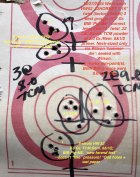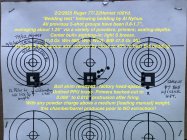Here are a couple of pics regarding the 22Hornet proceedings - the HW 52 stuff is to display the tendency for "central thickening", or, almost trying to group respectably. The Win. 1885 shoots about the same, albiet via a different powder . . . and the Winchester falling-block tolerates much more pressure - that is, it extracts even maximum "book" loads. The HW 52 and the Ruger 77 have relatively weak extractors.
Following firing, neither of the falling-block actions produce cases with primer protrusion - that is why I have included/referenced them: fired case result in flush primer : case-head face. On the other hand, the Ruger 77/22Hornet, with the "as is" factory bolt/ head-space, produces [fired] primer protrusion of 0.008" to 0.010". Installing a shim, which makes for ZERO bolt-nose to barrel face [clearance] reduces the protrusion to between 0.005" and 0.006" - at best, undesirably excessive. See above.
See above.
Following Al completing the bedding job, as compared to before, the average (for 5-shot 100 Yd. groups) has been reduced by about 38% - this via almost every powder tested. Per Steve Kostinach (post #10, above), the bedded 77/Hornet has taken a liking to Win.680 (1978 vintage), but still, lacks any "WOW" factor . . . compared to the two-pieced stock rifles, just mediocre patterns.
So, the next step, as Al and I have discussed will be to "Ackleyize", or, K this barrel, in an attempt to determine if the head-space is affecting precision, or, if the lack thereof is simply a mediocre barrel (not unlikely). At least, the two-piece stocked rifles, which I am likely "ham-handing", ARE TRYING to shoot groups! Grouping for both the Weihrauch, and the Winchester were reduced by making and installing pillar-bedded for-ends but still get a "flier" on almost every group!
Grouping for both the Weihrauch, and the Winchester were reduced by making and installing pillar-bedded for-ends but still get a "flier" on almost every group!  For, "what they are", I can live with the results . . . a bolt action - even a factory deal- should do WAY better than this Ruger - it doesn't even try.
For, "what they are", I can live with the results . . . a bolt action - even a factory deal- should do WAY better than this Ruger - it doesn't even try.  RG
RG
This target: 200 Yd. NBRSA score, shot @ 100 Yd.: 1/2" ring spacing.

This target: aiming squares = 3/4" with 1/4" ring spacing. Oh - that "B-$" should have been, 40% of B-4 bedding!

P.S. If you can name a [suitable burn-rate] powder, and some which are border-line, I've probably provided them an opportunity to perform in these Hornets. I'm finding them frustrating, but interesting - a new challenge. None of the three are particularly fond of Lil'Gun, which seems to be the contemporary, "go to" powder.
None of the three are particularly fond of Lil'Gun, which seems to be the contemporary, "go to" powder.
Following firing, neither of the falling-block actions produce cases with primer protrusion - that is why I have included/referenced them: fired case result in flush primer : case-head face. On the other hand, the Ruger 77/22Hornet, with the "as is" factory bolt/ head-space, produces [fired] primer protrusion of 0.008" to 0.010". Installing a shim, which makes for ZERO bolt-nose to barrel face [clearance] reduces the protrusion to between 0.005" and 0.006" - at best, undesirably excessive.
Following Al completing the bedding job, as compared to before, the average (for 5-shot 100 Yd. groups) has been reduced by about 38% - this via almost every powder tested. Per Steve Kostinach (post #10, above), the bedded 77/Hornet has taken a liking to Win.680 (1978 vintage), but still, lacks any "WOW" factor . . . compared to the two-pieced stock rifles, just mediocre patterns.
So, the next step, as Al and I have discussed will be to "Ackleyize", or, K this barrel, in an attempt to determine if the head-space is affecting precision, or, if the lack thereof is simply a mediocre barrel (not unlikely). At least, the two-piece stocked rifles, which I am likely "ham-handing", ARE TRYING to shoot groups!
This target: 200 Yd. NBRSA score, shot @ 100 Yd.: 1/2" ring spacing.

This target: aiming squares = 3/4" with 1/4" ring spacing. Oh - that "B-$" should have been, 40% of B-4 bedding!

P.S. If you can name a [suitable burn-rate] powder, and some which are border-line, I've probably provided them an opportunity to perform in these Hornets. I'm finding them frustrating, but interesting - a new challenge.
Last edited:


















